In addition to this lovely position as a blogger for PCUR, I am also a Learning Consultant at McGraw. (*shameless plug*: Learning Consultations at McGraw are individual hour sessions with a student (like me!) where you come up with strategies on how to best handle your studies at Princeton). Last year, a couple consultants volunteered for the inaugural episode of McGraw’s podcast, “Making Learning Audible,” where we talked about finding balance between work and relaxation over winter break. During winter break in my first year at Princeton, I put a lot of pressure on myself to study intensively for exams but ended up just overwhelming myself and doing nothing. Any attempt to actively work on my essays to reach my high standard of getting super ahead on my Dean’s Date papers was met with instant exhaustion.

However, I said in the podcast: “For my sophomore winter break, I learned from that, and all I wanted was just a good place to start when I got back. I did not put a lot of pressure on myself. I let all the work that I had to do be kind of passive and if something came to mind that I really liked I would jot it down and get back to it”.
In this post, I’ll unpack what I meant by “passive work.” Active brainstorming, in my experience, is choosing to set aside time to sit down and build an essay or open-ended question on an exam from scratch. So, what does it look like to stretch out this brainstorm period so when you sit down to write, the paragraphs basically form themselves? Here are some tips on how I’ve been able to cut down on brainstorming time and get down to business:
- Theme Tracing: A good start for passive work is being able to trace the most important themes in the course for easy reference. The first thing I’ll do is look at the syllabus, which will often denote the topics and concepts meant to be discussed that week. If concepts aren’t specifically noted in the syllabus, I’ll take note of ideas repeated in class, or just pick a topic that interested me from the readings and see how that develops throughout the course. Keeping this key concept in mind, I’ll take notes on the readings, and interpret class discussion with these chosen themes as a lens. Therefore, by the time that essay question comes around, whether on an assignment or timed exam, I’ll have some developed ideas already that I can build upon.
- Blackboard Post Redux: Those 300 word responses you do weekly aren’t meant to be a thorn in your side, but to keep track of the objectives of the course—they can actually be key tip #1! I like to use my blackboard posts as mini build-ups to potential essay topics (actually a final paper I wrote in my French class last year was inspired by a Blackboard post!). If the professor gave a prompt in Blackboard, I’ll revisit my response as a summary of the themes of that week. If the professor didn’t have a prompt, then I can revisit what my takeaway from that week’s readings were in my own words. This makes for a natural starting point for longer-form responses.
- What would the professor say?: I ask myself this at the end of every class—what would my professor think the takeaway should be from the class based on the discussion, readings, and lecture content. I found that after consistently asking myself this, I intuitively build up a framework of my professor’s expectations: the key concepts, terms, and debates, I am meant to understand and implement. That way, when the long-form assignment comes up, I already have this in mind, and can use this information to easily build off of the prompt.
- What did you learn today?: This is a twist on the third question that, in my experience, allows me to put the themes and key concepts of the course in my own words, much like in tip #2. Imagining someone asking you this question allows you to simplify complex concepts down to a colloquial level, making the responses to this question an easy reference point. When you see the prompt, you already will have framed the concepts in a way that you understand, so there’s no mid-brainstorm confusion.
Hopefully these tips can help jumpstart your essays as quickly as possible so you can efficiently put your time to use!
—Elise Freeman, Humanities Correspondent

